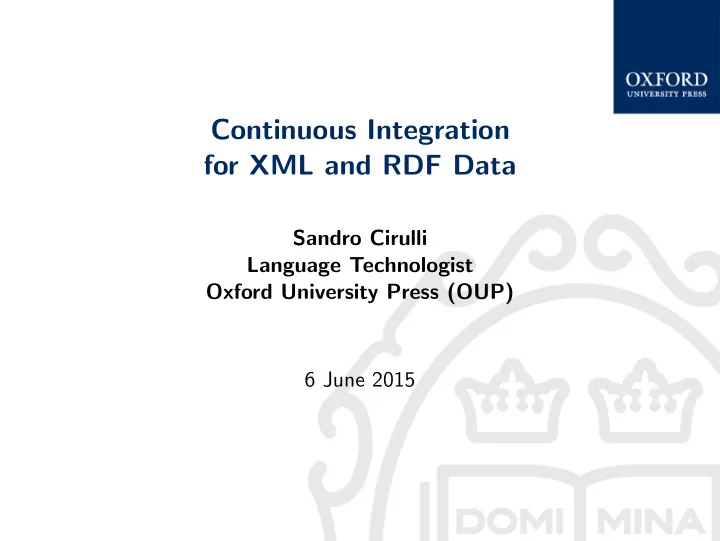

Continuous Integration for XML and RDF Data Sandro Cirulli Language Technologist Oxford University Press (OUP) 6 June 2015
Table of contents 1. Context 2. Continuous Integration with Jenkins 3. Automatic Deployment with Docker 4. Future Work
Oxford University Press Context ◮ Oxford University Press (OUP) is a world-renowned dictionary publisher ◮ OUP launched the Oxford Global Languages (OGL) initiative to digitize under-represented languages ◮ Language data is converted into XML and RDF 3/19
Where we started from Challenges ◮ OUP dictionary data was originally developed for print products ◮ OUP acquired dictionaries from other publishers in various formats ◮ Data conversions were performed by freelancers using various programming languages, tools, and development environments ◮ No testing, no code reuse 4/19
Our aim ◮ Produce lean, machine-interpretable XML and RDF ◮ Leverage Semantic Web technologies for linking and inference ◮ Convert tens of language resources in a scalable, maintainable, and cost-effective manner 5/19
Continuous Integration What it is ◮ Continuous Integration (CI) is a software development practice where a development team commits their work frequently and each commit is integrated by an automated build tool detecting integration errors ◮ CI requires a build server to monitor changes in the code, run tests, build, and notify developers ◮ We use Jenkins as it is the most popular open-source CI server 6/19
Continuous Integration Workflow and components 7/19
Continuous Integration Nightly Builds ◮ Nightly builds are automated builds scheduled on a nightly basis ◮ We currently builds XML and RDF for 7 datasets ◮ Nightly builds currently take on average 5 hours on a multi-core Linux machine with 132 GB RAM ◮ Builds are parallelized using 8 cores 8/19
Continuous Integration Unit Testing ◮ XSpec for XSLT code ◮ RDFUnit for RDF data ◮ XProcspec for XProc pipeline ◮ Test results are converted into JUnit reports via XSLT ◮ Unit tests are run shortly after a developer commits the code 9/19
Continuous Integration Monitor View 10/19
Continuous Integration Benefits of CI ◮ Code reuse : on average, 70-80% of the code could be reused for new XML/RDF conversions ◮ Code quality : regression bugs are avoided ◮ Bug fixes : bugs are spotted quickly and fixed more rapidly ◮ Automation : no manual steps, faster and less error-prone build process ◮ Integration : reduced risks, time, and costs for integration with other systems 11/19
Continuous Integration Jenkins Demo 12/19
Automatic Deployment with Docker Docker ◮ Docker is an open source platform for deploying distributed applications running inside containers ◮ Docker provides development and operational teams with a shared, consistent environment for development, testing, and release ◮ Docker avoids the classic ’ but it worked on my machine ’ issue ◮ Docker allows applications and their dependencies to be moved portably across development and production environments 13/19
Docker Containers 14/19
Automatic Deployment with Docker Dockerfile FROM platform_base MAINTAINER Sandro Cirulli <sandro.cirulli@oup.com> # eXist-DB version ENV EXISTDB_VERSION 2.2 # install exist WORKDIR /tmp RUN curl -LO http://downloads.sourceforge.net/exist/ Stable/${EXISTDB_VERSION}/eXist-db-setup-${ EXISTDB_VERSION}.jar ADD exist-setup.cmd /tmp/exist-setup.cmd # run command line configuration RUN expect -f exist-setup.cmd 15/19
Automatic Deployment with Docker Dockerfile (cont.) RUN rm eXist-db-setup-${EXISTDB_VERSION}.jar exist- setup.cmd # set persistent volume VOLUME /data/existdb WORKDIR /opt/exist # change default port to 8008 RUN sed -i ’s/default="8080"/default="8008"/g’ tools/ jetty/etc/jetty.xml EXPOSE 8008 8443 ENV EXISTDB_HOME /opt/exist CMD bin/startup.sh 16/19
Future Work ◮ Scalability : cloud instances to run compute-intensive processes, distribute builds across slave machines ◮ Availability : Circuit Breaker Design Pattern ◮ Code coverage : lack of code coverage tools for XSLT (XSpec and Cakupan are the best we could find) ◮ Deployment orchestration : docker-compose to orchestrate Docker containers 17/19
Acknowledgements The work described here was carried out by a developers team at OUP: ◮ Khalil Ahmed ◮ Nick Cross ◮ Matt Kohl ◮ and myself 18/19
Thank you for your attention! Any questions? Slides available at: www.sandrocirulli.net/xml-london-2015 Contact me at: sandro.cirulli@oup.com
Recommend
More recommend